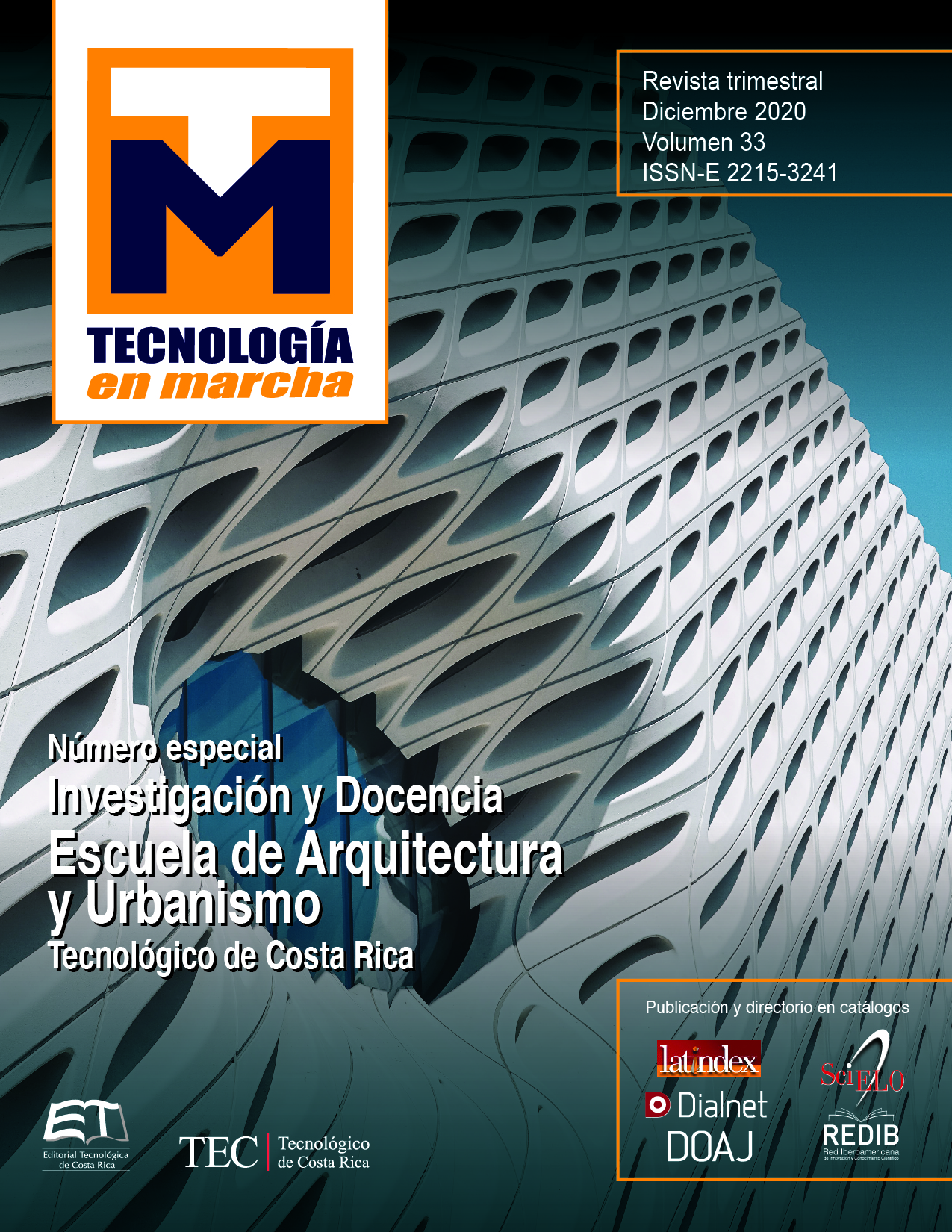Study and planning of the optimal environmental conditions in the constructive practice of a typical office space, to be located in the tropics of Costa Rica, promoting the use of daylight
Main Article Content
Abstract
Research for recommendations and constructive solutions applied to office spaces that represent the least impact on the natural environment and that promote and encourage for the use of daylight as the primary source of lighting.
Through the descriptive methodology, the most relevant issues on sustainability in the construction of office spaces were raised from a systemic and interdisciplinary approach.
The main energy consumption patterns of the offices in Costa Rica were examined to support the importance of energy saving and variables that impact sustainability such as construction materials, recycling practices and reuse of materials and the search for passive strategies were analyzed to the use of daylight.
Hypothesis were formulated in the search for more energy-efficient and sustainable workspaces, which through the technique of data collection and bibliographic search, came to pose the most relevant on the subject of study.
This research concluded on the need to search for a model system of strategies that would allow the use of all light energy in the internal space of the offices in Costa Rica, to generate more comfortable and visually pleasing environments, encouraging energy savings and eliminating in some periods of the day, the dependence on the use of artificial lighting; likewise, it was concerned with the search for less polluting construction materials and the generation of passive strategies for these spaces.
Article Details

This work is licensed under a Creative Commons Attribution-NonCommercial-NoDerivatives 4.0 International License.
Los autores conservan los derechos de autor y ceden a la revista el derecho de la primera publicación y pueda editarlo, reproducirlo, distribuirlo, exhibirlo y comunicarlo en el país y en el extranjero mediante medios impresos y electrónicos. Asimismo, asumen el compromiso sobre cualquier litigio o reclamación relacionada con derechos de propiedad intelectual, exonerando de responsabilidad a la Editorial Tecnológica de Costa Rica. Además, se establece que los autores pueden realizar otros acuerdos contractuales independientes y adicionales para la distribución no exclusiva de la versión del artículo publicado en esta revista (p. ej., incluirlo en un repositorio institucional o publicarlo en un libro) siempre que indiquen claramente que el trabajo se publicó por primera vez en esta revista.
References
G. Maps, “Google Maps,” 14 Enero 2019. [Online]. Available: https://www.google.com/maps/d/viewer?mid=11X_5AoyPeeJBvWnFDnWO40fhYaQ&msa=0&ll=10.141931999999999%2C-83.75976600000001&z=8.
I. E. Gómez and W. Fernández, “Variación interanual de la temperatura en Costa Rica,” Tópicos Meteorológico y Oceanográficos, pp. 27-44, 1996.
DIRECCIÓN DE INFRAESTRUCTURA Y EQUIPAMIENTO EDUCATIVO, Ministerio de Educación Pública, “mep.go.cr,” Julio 2010. [Online]. Available: https://diee.mep.go.cr/sites/all/files/diee_mep_go_cr/preguntas-frecuentes/compendio_normas_edficios_para_educacion.pdf. [Accessed 2020].
N. Lasry, E. Mazur and J. Watkins, “Peer instruction: From Harvard to the two-year college.,” American journal of Physics, vol. 76, no. 11, pp. 1066-1069, 2008.
C. Coll, “Aprender y enseñar con las TIC: expectativas, realidad y potencialidades,” Boletín de la institución libre de enseñanza, vol. 72, no. 1, pp. 7-40, 2008.
G. Gómez and A. Villareal, “Cultura, Espacios para la Educación,” in Escala, Bogotá, 2004.
L. L. Fernandes, E. S. Lee and G. & Ward, “Lighting energy savings potential of split-pane electrochromic windows controlled for daylighting with visual comfort,” Energy and Buildings, vol. 61, pp. 8-20, 2013.
A. Pattini and C. Kirschbaum, “Evaluación subjetiva de aulas iluminadas con luz natural,” Avances en energías renovables y medio ambiente, 1998.
R. V. Ralegaonkar and R. Gupta, “Review of intelligent building construction: A passive solar architecture approach,” Renewable and Sustainable Energy Reviews, vol. 14, no. 8, pp. 2238-2242, 2010.
S. Hoses, G. San Juan, M. Melchiori and G. Viegas, “INCIDENCIA DE ESTRATEGIAS DE CONTROL SOLAR EN LA ILUMINACIÓN NATURAL DE AULAS ESCOLARES,” in ENTAC, Parana, 2002.
B. Arranz, E. Rodríguez-Ubinas, C. Bedoya-Frutos and S. Vega-Sánchez, “Evaluation of three solar and daylighting control systems based on Calumen II, Ecotect and radiance simulation programmes to obtain an energy efficient and healthy interior in the experimental building Prototype SD10,” Energy and Buildings, 83, ., pp. 225-236, 2014.
A. Ávila, “Sistema de iluminación integrada para un espacio de oficina en el trópico de Costa Rica. Tesis Doctoral,” Universidad Politécnica de Madrid, Madrid, 2010.
K. Steemers, “Daylighting design: Enhancing energy efficiency and visual quality,” Renewable Energy, pp. 950-958., 1994.
P. Littlefair, “Daylight prediction in atrium buildings.,” Solar energy, pp. 105-109, 2002.
L. O. Beltran, E. S. Lee and S. E. Selkowitz, “Advanced optical daylighting systems: light shelves and light pipes,” Journal of the illuminating engineering society, pp. 91-106, 1997.
U. Berardi and H. K. Anaraki, “Analysis of the impacts of light shelves on the useful daylight illuminance in office buildings in Toronto,” Energy Procedia, pp. 1793-1798, 2015.
J. I. R. Olabuénaga, Metodología de la investigación cualitativa, Universidad de Deusto: Gedisa, 2012.

